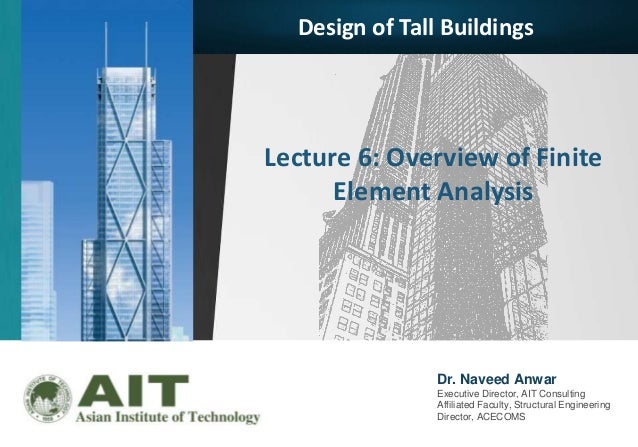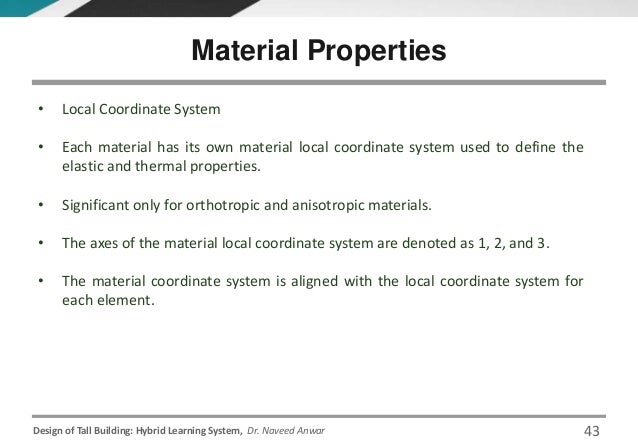Elastic Crack Growth Finite Elements Lecture
The three fracture modes Fracture mechanics is the field of concerned with the study of the propagation of cracks in materials. It uses methods of analytical to calculate the driving force on a crack and those of experimental solid mechanics to characterize the material's resistance to. In modern, fracture mechanics is an important tool used to improve the performance of mechanical components.
Elastic crack growth in finite elements with minimal remeshing. Belytschko, Corresponding author. E-mail address: t-belytschko@nwu.edu.
It applies the of and behavior of materials, in particular the theories of and, to the microscopic found in real materials in order to predict the macroscopic mechanical behavior of those bodies. Is widely used with fracture mechanics to understand the causes of failures and also verify the theoretical failure predictions with real life failures. The prediction of crack growth is at the heart of the mechanical design discipline. There are three ways of applying a force to enable a crack to propagate:. Mode I fracture – Opening mode (a normal to the plane of the crack),.
Mode II fracture – Sliding mode (a acting parallel to the plane of the crack and perpendicular to the crack front), and. Mode III fracture – Tearing mode (a shear stress acting parallel to the plane of the crack and parallel to the crack front). Contents. Motivation The processes of material manufacture, processing, machining, and forming may introduce flaws in a finished mechanical component. Arising from the manufacturing process, interior and surface flaws are found in all metal structures.
Not all such flaws are unstable under service conditions. Fracture mechanics is the analysis of flaws to discover those that are safe (that is, do not grow) and those that are liable to propagate as cracks and so cause of the flawed structure. Despite these inherent flaws, it is possible to achieve through analysis the safe operation of a structure.
Fracture mechanics as a subject for critical study has barely been around for a century and thus is relatively new. Fracture mechanics should attempt to provide quantitative answers to the following questions:. What is the strength of the component as a function of crack size?. What crack size can be tolerated under service loading, i.e.
What is the maximum permissible crack size?. How long does it take for a crack to grow from a certain initial size, for example the minimum detectable crack size, to the maximum permissible crack size?. What is the service life of a structure when a certain pre-existing flaw size (e.g. A manufacturing defect) is assumed to exist?. During the period available for crack detection how often should the structure be inspected for cracks? Linear elastic fracture mechanics Griffith's criterion. The split apart by while in harbor, 1943.
But a problem arose for the NRL researchers because naval materials, e.g., ship-plate steel, are not perfectly elastic but undergo significant at the tip of a crack. One basic assumption in Irwin's linear elastic fracture mechanics is small scale yielding, the condition that the size of the plastic zone is small compared to the crack length. However, this assumption is quite restrictive for certain types of failure in structural steels though such steels can be prone to brittle fracture, which has led to a number of catastrophic failures. Linear-elastic fracture mechanics is of limited practical use for structural steels and testing can be expensive. Elastic–plastic fracture mechanics.
Which separated from, leading to a fatal crash Most engineering materials show some nonlinear elastic and inelastic behavior under operating conditions that involve large loads. In such materials the assumptions of linear elastic fracture mechanics may not hold, that is,. the plastic zone at a crack tip may have a size of the same order of magnitude as the crack size. the size and shape of the plastic zone may change as the applied load is increased and also as the crack length increases. Therefore, a more general theory of crack growth is needed for elastic-plastic materials that can account for:. the local conditions for initial crack growth which include the nucleation, growth, and coalescence of voids (decohesion) at a crack tip. a global energy balance criterion for further crack growth and unstable fracture.

CTOD Historically, the first parameter for the determination of fracture toughness in the elasto-plastic region was the (CTOD) or 'opening at the apex of the crack' indicated. This parameter was determined by Wells during the studies of structural steels, which due to the high toughness could not be characterized with the linear elastic fracture mechanics model. He noted that, before the fracture happened, the walls of the crack were leaving and that the crack tip, after fracture, ranged from acute to rounded off due to plastic deformation. In addition, the rounding of the crack tip was more pronounced in steels with superior toughness. There are a number of alternative definitions of CTOD. The two most common definitions, CTOD is the displacement at the original crack tip and the 90 degree intercept. The latter definition was suggested by Rice and is commonly used to infer CTOD in finite element models of such.
Note that these two definitions are equivalent if the crack tip blunts in a semicircle. Most laboratory measurements of CTOD have been made on edge-cracked specimens loaded in three-point bending. Early experiments used a flat paddle-shaped gage that was inserted into the crack; as the crack opened, the paddle gage rotated, and an electronic signal was sent to an x-y plotter.
This method was inaccurate, however, because it was difficult to reach the crack tip with the paddle gage. Today, the displacement V at the crack mouth is measured, and the CTOD is inferred by assuming the specimen halves are rigid and rotate about a hinge point (the crack tip). R-curve An early attempt in the direction of elastic-plastic fracture mechanics was crack extension resistance curve, or R-curve.
This curve acknowledges the fact that the resistance to fracture increases with growing crack size in elastic-plastic materials. The R-curve is a plot of the total energy dissipation rate as a function of the crack size and can be used to examine the processes of slow stable crack growth and unstable fracture. However, the R-curve was not widely used in applications until the early 1970s.
The main reasons appear to be that the R-curve depends on the geometry of the specimen and the crack driving force may be difficult to calculate. J-integral.
Anderson (1995). Fracture Mechanics: Fundamentals and Applications.
Ewalds; R.J.H. Wanhill (1984). Fracture Mechanics. Edward Arnold and Delftse Uitgevers Maatschappij. (1921), (PDF), Philosophical Transactions of the Royal Society of London, A, 221: 163–198,:,:, archived from (PDF) on 2006-10-16. Johnson, K. L.; Kendall, K.; Roberts, A.
324 (1558): 301–313. Popov, Valentin L.; Pohrt, Roman; Li, Qiang (2017-09-01). 5 (3): 308–325.
Erdogan (2000) Fracture Mechanics, International Journal of Solids and Structures, 37, pp. ^ Irwin G (1957), Analysis of stresses and strains near the end of a crack traversing a plate, Journal of Applied Mechanics 24, 361–364.
Orowan, E., 1949. Fracture and strength of solids. Reports on Progress in Physics XII, 185–232. ^ Liu, M.; et al.
Engineering Fracture Mechanics. 149: 134–143. Alireza Bagher Shemirani; Haeri, H. (2017), 'A review paper about experimental investigations on failure behaviour of non-persistent joint', Geomechanics and Engineering, 13 (4): 535–570,:. ^ Weisshaar, Terry (July 28, 2011).
Aerospace Structures- an Introduction to Fundamental Problems. West Lafayette, IN: Purdue University. Handbook for Damage Tolerant Design. LexTech, Inc. Retrieved 20 November 2016.
Handbook for Damage Tolerant Design. LexTech, Inc.
Retrieved 20 November 2016. ^ (1968), (PDF), Journal of Applied Mechanics, 35: 379–386,:,:. Barenblatt, G. (1962), 'The mathematical theory of equilibrium cracks in brittle fracture', Advances in Applied Mechanics, 7: 55–129,:.
Dugdale, D. (1960), 'Yielding of steel sheets containing slits', Journal of the Mechanics and Physics of Solids, 8 (2): 100–104,:,:. Willis, J. (1967), 'A comparison of the fracture criteria of Griffith and Barenblatt', Journal of the Mechanics and Physics of Solids, 15 (3): 151–162,:,:. Xu, X.P.; Needleman, A. (1994), 'Numerical simulations of fast crack growth in brittle solids', Journal of the Mechanics and Physics of Solids, 42 (9): 1397–1434,:,:.
Camacho, G. T.; Ortiz, M. (1996), 'Computational modelling of impact damage in brittle materials', International Journal of Solids and Structures, 33 (20-22): 2899–2938,:. Mirsayar, M. M., 'Mixed mode fracture analysis using extended maximum tangential strain criterion', Materials & Design, 2015, doi:10.1016/j.matdes.2015.07.135. Bibliography. Buckley, C.P.

'Material Failure', Lecture Notes (2005),. Further reading. Davidge, R.W., Mechanical Behavior of Ceramics, Cambridge Solid State Science Series, (1979). Demaid, Adrian, Fail Safe, Open University (2004). Green, D., An Introduction to the Mechanical Properties of Ceramics, Cambridge Solid State Science Series, Eds.
Clarke, D.R., Suresh, S., Ward, I.M. (1998). Lawn, B.R., Fracture of Brittle Solids, Cambridge Solid State Science Series, 2nd Edn. (1993). Farahmand, B., and Glassco, J.
Finite Elements Lecture Notes
(1997), Chapman & Hall. Chen, X., Mai, Y.-W., Imperial College Press, (2012). A.N.
Finite Elements Audio Racks
Mars, In: James E. Mark, Burak Erman and Mike Roland, Editor(s), The Science and Technology of Rubber, Fourth edition, Academic Press, Boston, 2013, pp. 473–516, 10.1016/B978-0-12-394584-6.00010-8.
Zehnder, Alan., SpringerLink, (2012). External links. by Prof. John Hutchinson, Harvard University. by Prof. John Hutchinson, Harvard University.
by Prof. Piet Schreurs, TU Eindhoven, Netherlands. by Dr. Bob McGinty, Mercer University. by Prof. Rui Huang, Univ.